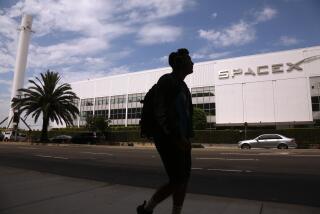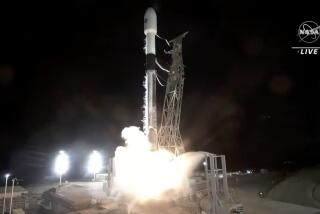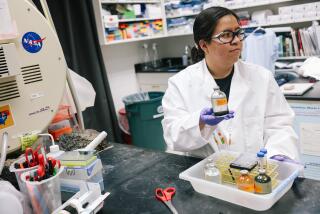Classes Learn Space ‘Is Just Starting’ : Special Hands-On Program Teaches Students About Rockets and Comets
- Share via
It’s not every day that middle school students get to make comets with their own hands or launch rockets under the direction of . . . a rocket scientist.
But there they were, 400 of them at the California Museum of Science and Industry, mixing dry ice, soil, water, balsamic acid and Worcestershire sauce into frozen balls of ice and dirt.
“It was cool because . . . it came out nasty,” said Gabriel Chavez, 12, a seventh-grader at South Gate Middle School, who created one of the “comets” with his classmate and buddy, Matthew Jaramillo.
Directing the “nasty” space-age exercise was Randii Wessen, a science systems engineer with Jet Propulsion Laboratory in Pasadena.
It was all part of the Youth Science Symposium, subtitled “Your Place in Space,” held Wednesday at the Exposition Park museum for seventh- and eighth-graders from eight Los Angeles County schools.
Wessen did not seem to mind if the “lab work” was like playtime for the youngsters, who were drawn from science classes.
“I think that space doesn’t seem real to the kids because it is out there and we are here,” he said. “Anything that we can do to make it tangible, to make it real, will help them to better understand.”
The rocket-making was going on at another trailer classroom on the museum grounds.
Ingrid Rodriguez, 11, a sixth-grader at Marina del Rey Junior High School, then got to launch her missile--made out of a syringe, a cork and a bottle filled with water--on the museum’s grounds.
The day was not all hands-on exercises--while they worked, the students were taught the fundamentals of comets and rockets.
The program, sponsored by the Lockheed Corp., also featured the new IMAX film “Destiny in Space” and short lectures by Wessen, aerospace curator Kenneth E. Phillips and Brenda Forman, director of marketing policy at Lockheed.
Wessen told the middle schoolers, “Space is not over, it is just starting.”
Phillips told them that they did not have to be the smartest students to be the best at a chosen endeavor--a pep talk amid the science.
“They are at a particularly vulnerable age,” he said later. “We want to bolster their confidence in their abilities.”
The message hit home with 12-year-old Marie Meza.
“Anybody can be a scientist,” she said.
“It doesn’t matter if you are a girl or a boy, it just matters how you think.”
More to Read
Sign up for The Wild
We’ll help you find the best places to hike, bike and run, as well as the perfect silent spots for meditation and yoga.
You may occasionally receive promotional content from the Los Angeles Times.






